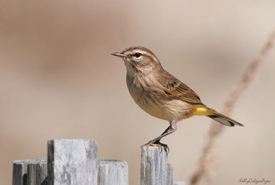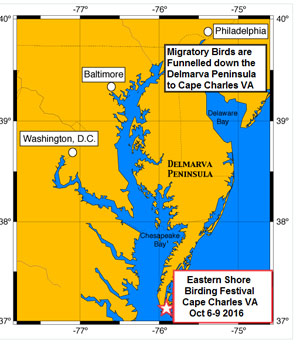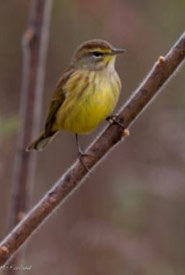Thank you Canada...The warblers have returned to Virginia!

Palm warbler (Photo by Kelly Colgan Azar)
We recently learned from our friends in Canada that the palm warblers had concluded a successful summer breeding season and were on their way south; and now, we are pleased to share, “They’re here!” Palm warblers and other warblers have begun stopping over in Virginia to refuel and rest before they continue their southward journey along the Atlantic Flyway towards their wintering grounds. Their arrival marks the start of the fall bird migration peak in Virginia, which will continue through mid-October.
Virginia’s Eastern Shore: A premiere fall migration event

Map by Eastern Shore Birding and Wildlife Festival
Fall presents a golden opportunity for bird watching on Virginia’s Eastern Shore. Bordered to the west by the Chesapeake Bay and to the east by the Atlantic Ocean, the Eastern Shore of Virginia is the long, slim southern tip of the larger Delmarva (Delaware-Maryland-Virginia) Peninsula. The unique shape of the peninsula and its position along the Atlantic Flyway creates a funnel-effect that concentrates migrating birds in a relatively small area while they are traveling southward each fall. For 24 years, the Eastern Shore Birding & Wildlife Festival has celebrated this migratory event and provides an excellent opportunity for all to witness fall migration in action.
Ensuring that these migratory birds have rich habitat resources that keep them well fed during their stopover on the Eastern Shore is critical to supporting them on their long journey. The Virginia Department of Game & Inland Fisheries works with a number of partners, such as the U.S. Fish and Wildlife Service, Virginia Department of Conservation and Recreation, Virginia Coastal Zone Management Program and The Nature Conservancy (U.S.), amongst many others, to conserve the Eastern Shore’s habitat for migratory birds.
Additional opportunities to view migrating warblers
If you can’t make it to the Eastern Shore, but still want a chance to observe the palm warbler and other migrating warblers, there are other opportunities in Virginia to do so! Just as in the spring, many warblers follow the path of the Appalachian Mountains, which provide rich habitat and dense protective cover for their migration stopovers. Some birds even meander through the central portion of the state from one habitat patch to the next. Check out the list of Virginia Birding & Wildlife Trail sites below for top locations where palm warblers and other migrating warblers can be observed during Virginia’s fall birding season.
Top Virginia locations to see palm warbler and other warblers in the fall
Virginia’s Eastern Shore (sites are listed north to south)
- Chincoteague National Wildlife Refuge
- Savage Neck Dunes Natural Area Preserve
- Cape Charles Natural Area Preserve
- Kiptopeke State Park
- Magothy Bay Natural Area Preserve
- Eastern Shore of Virginia National Wildlife Refuge
- Eastern Shore Birding & Wildlife Festival, Oct. 6 -9, 2016
Northern and Central Virginia
- Banshee Reeks Nature Preserve
- Leesylvania State Park
- James River Park
- Henricus Park/ Dutch Gap Conservation Area
Appalachian Mountains (sites are listed north to south)
- Sky Meadows State Park
- Switzer Lake Area
- Ivy Creek Natural Area
- Rockfish Gap Hawk Watch
- Spruce Creek Park
- Natural Bridge of Virginia
- Pandapas Pond
- Heritage Community Park and Natural Area
- Claytor Lake State Park
Get out and celebrate migratory bird conservation

Palm warbler (Photo by Kent McFarland)
Get outdoors in Virginia and seize the opportunity to enjoy the palm warblers this fall! It won’t be long before they continue south towards Florida and even beyond to the Caribbean, Mexico’s Yucatan Peninsula, Belize and Honduras!
While you’re enjoying the birds, please pause and take a moment to appreciate the many local and international habitats and conservation efforts that support the birds’ annual migration cycle. Our international blog exchange, One Sky Our Birds, is a celebration of one such conservation effort: the Migratory Bird Treaty, which has been critical to the cross-border conservation of migratory birds for 100 years.
Follow One Sky Our Birds to join the celebration and follow palm warblers on this year’s migration journey! Remember, birds don’t do borders!
This blog is reposted with permission from One Sky Our Bird's blog.


